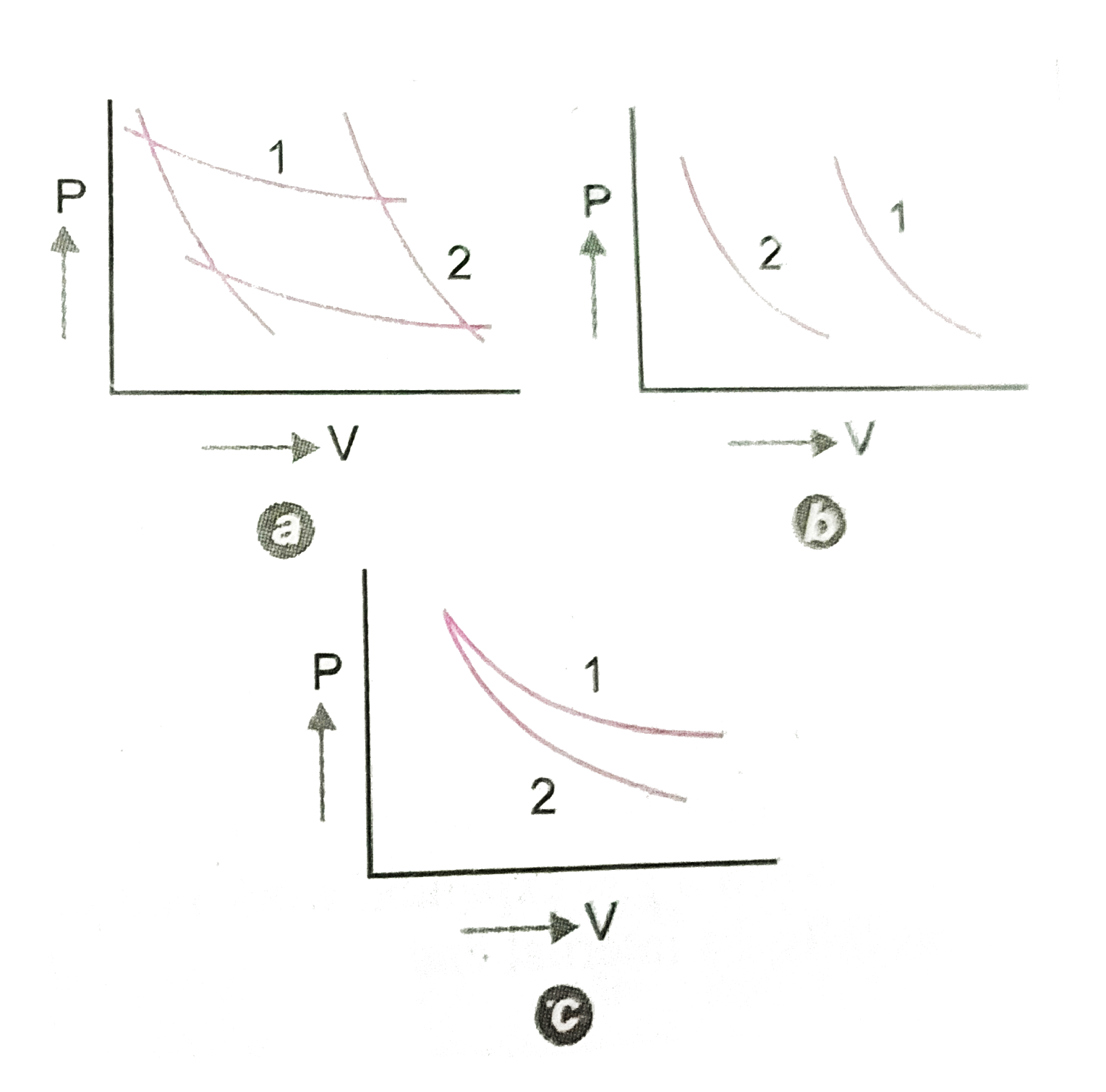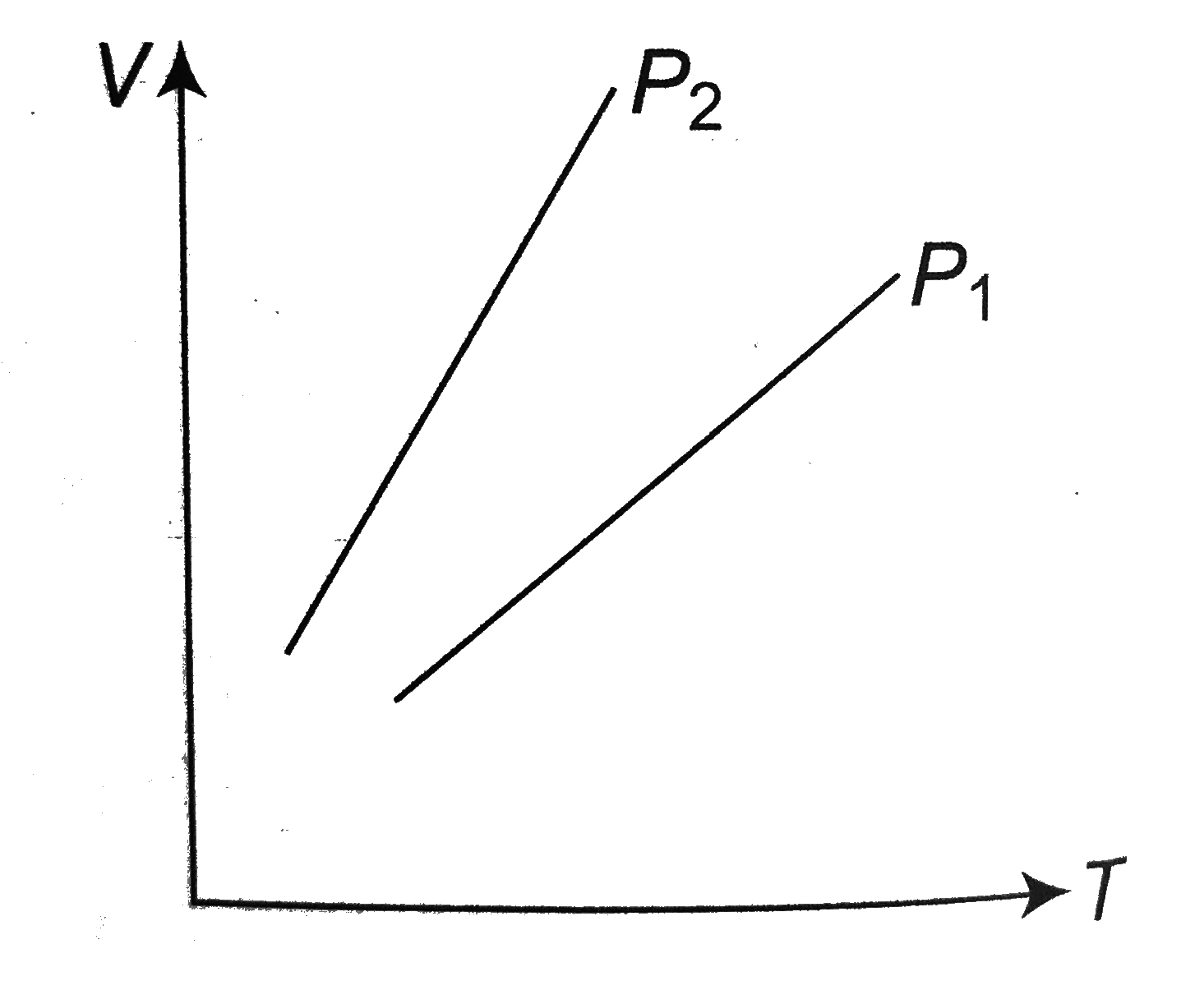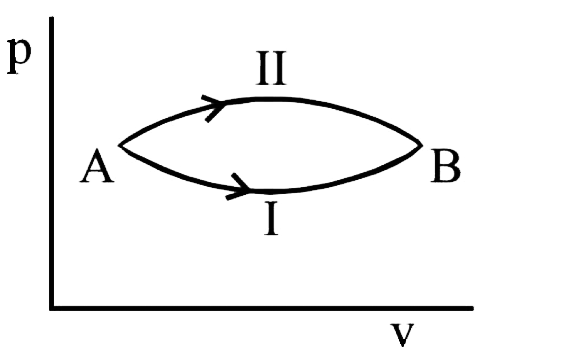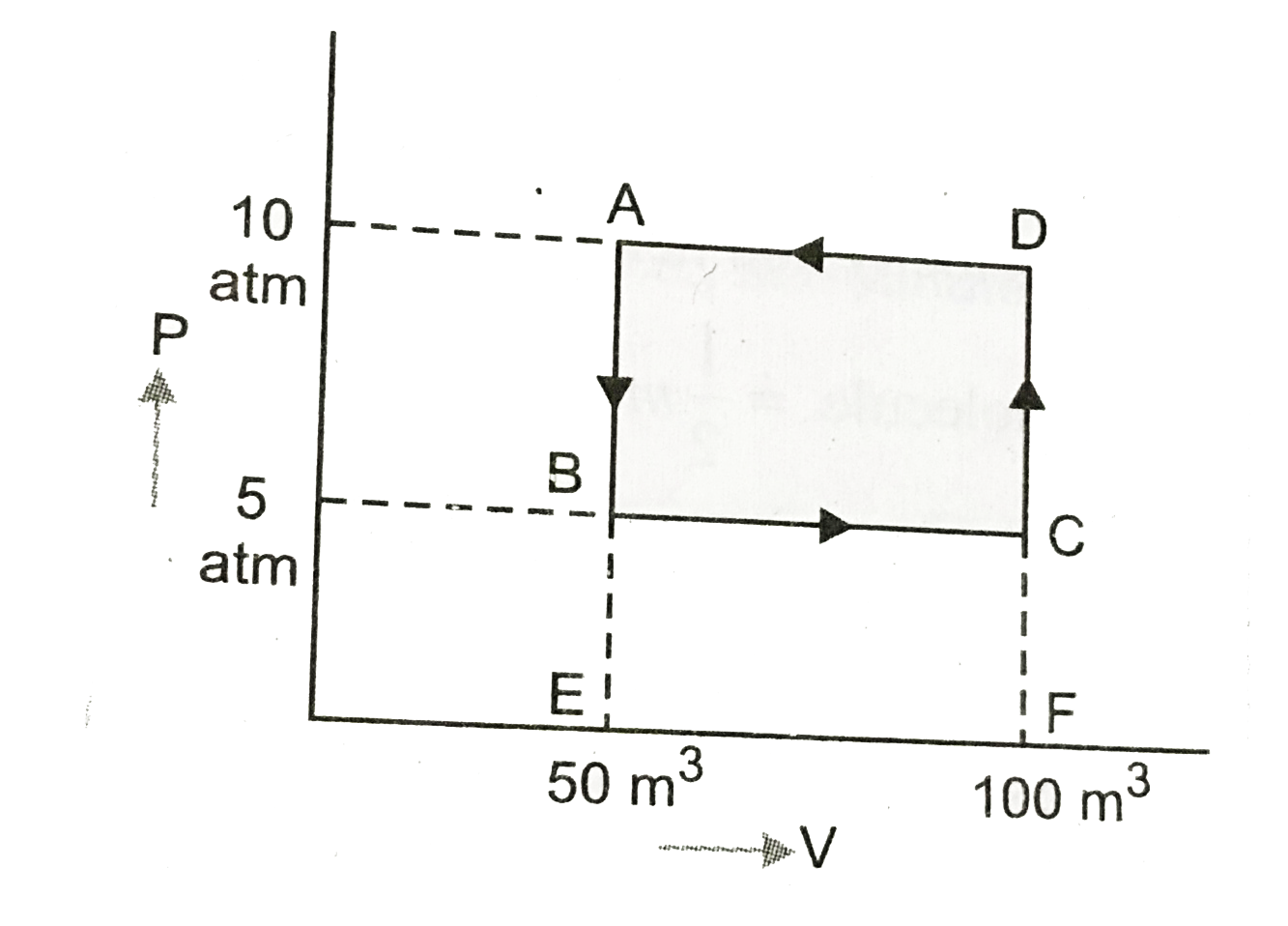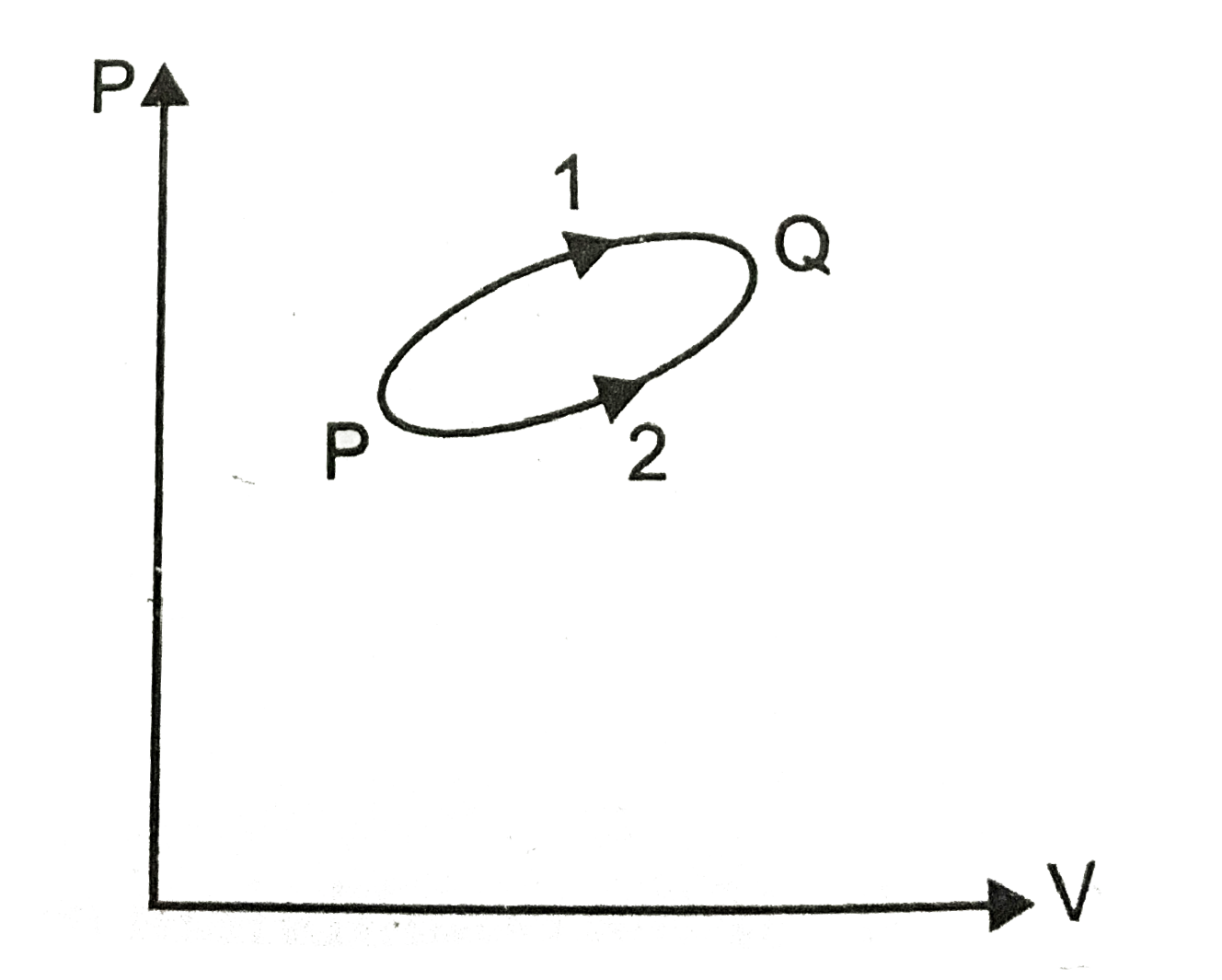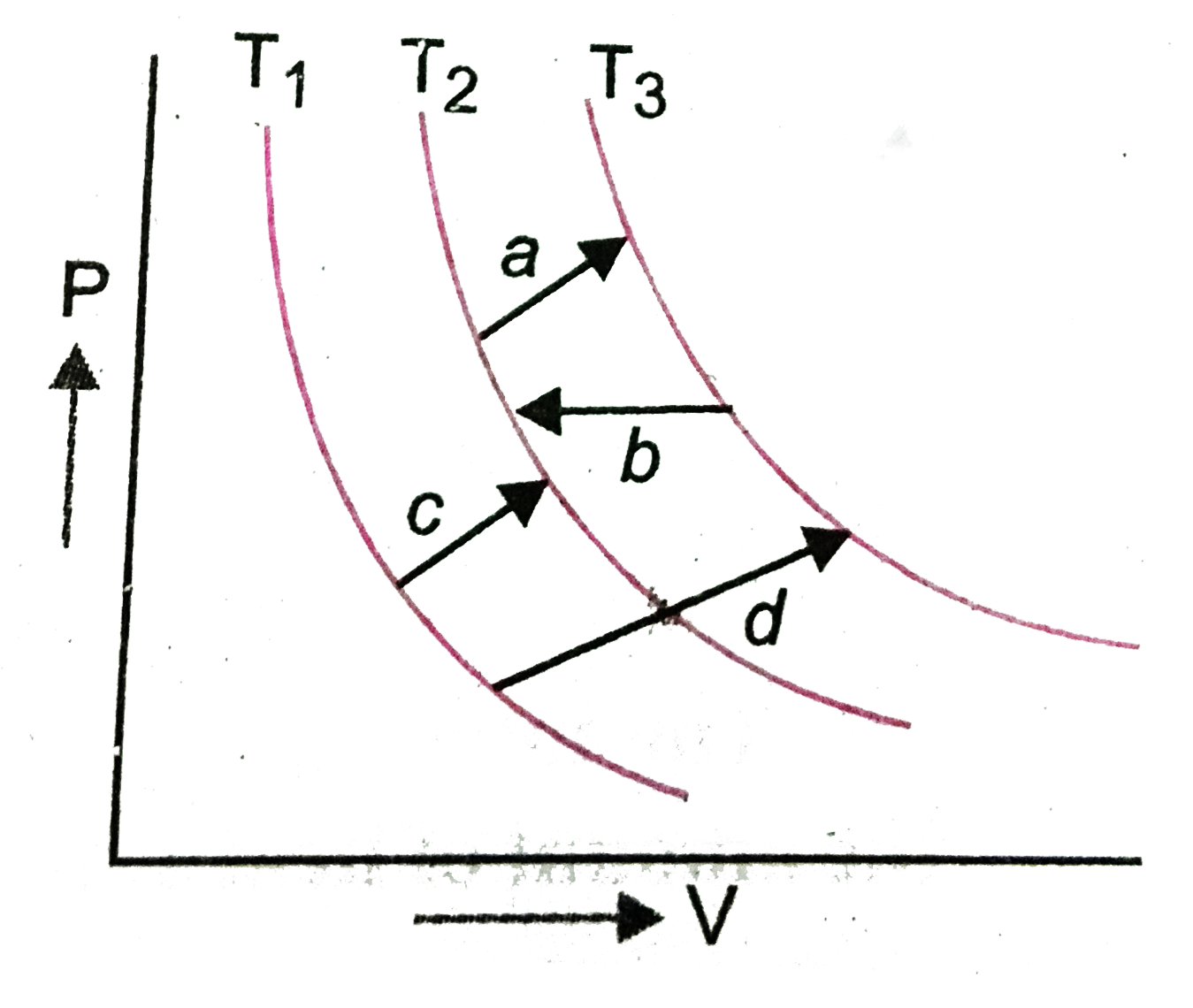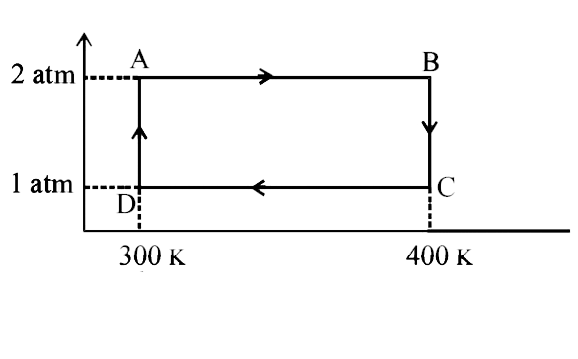Advanced problems for competitions from PRADEEP PHYSICS (HINGLISH) THERMODYNAMICS for Class 11
| Class 11 | PHYSICS |
| Chapter | THERMODYNAMICS |
| PRADEEP PHYSICS (HINGLISH) | Advanced problems for competitions |
| Medium | English |
| Academic Year | 2023-2024 |
Question 16
The P−V diagram for a cyclic process is a triangle ABC drawn in order (figure). The co-ordinates of A,B,C are (4,1),(2,4)and(2,1) respectively. The co-ordinates are in the order (P,V) Pressure is in Nm−2 and volume is in liter. Calculate work done during the process from A to B, B to C and C to A. Also, calculate work done in the complete cycle.View SolutionQuestion 21
A metal of mass 1 kg at constant atmospheric pressure and at initial temperature 20∘C is given a heat of 20000J. Find the following
(a) change in temperature,
(b) work done and
(c) change in internal energy.
(Given, specific heat =400J/kg−∘C, cofficient of cubical expansion, γ=9×10−5/∘C, density ρ=9000kg/m3, atmospheric pressure =105N/m2)View SolutionQuestion 23
A system is taken from state a to state c along the path adc (figure). The amount of heat absorbed is 10cals and work done on the gas is 138J. Calculate the work done on//by the gas when 20cals of heat are absorbed in taking the system from state a to state c along the path abc
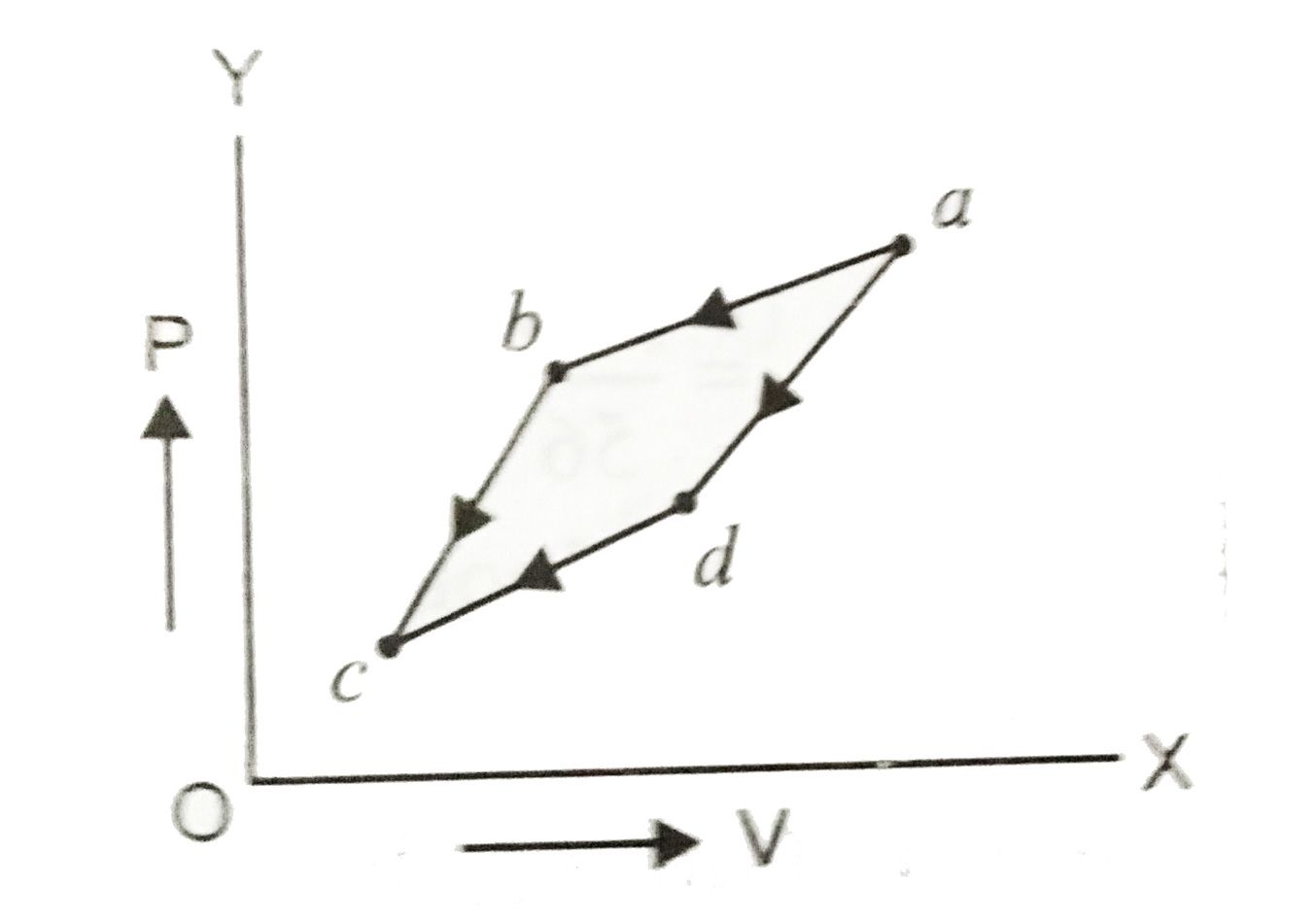 View Solution
View SolutionQuestion 40
A refrigerator is driven by 1000W electric motor having an efficiency of 60%. The refrigerator is considerd as a reversible heat engine operating between 273Kand303K. Calculate the time required by it to freeze 32.5kg of water at 0∘C. Heat losses may be rejected. Latent heat of fusion of ice =336×103Jkg−1. View SolutionQuestion 42
A carnot engine having a perfect gas aas the working substance is driven backwards and is used for freezing water already at 0∘C. If the engine is driven by 500W electric motor with an efficiency of 60% how long will it take to freeze 15kg of water? The working temps of the engine are 15∘C and 0∘C. The system involves no energy losses. Given latent heat of ice =333×103Jkg−1.View SolutionQuestion 130
An ideal gas expands isothermally along AB and does 700J of work. How much heat does the gas exchange along AB? The gas then expands adiabarically along BC and does 400J of work. When the gas returns to A along CA, it exhausts 100J of heat to the surroundings. How much work is done on the gas along this path?
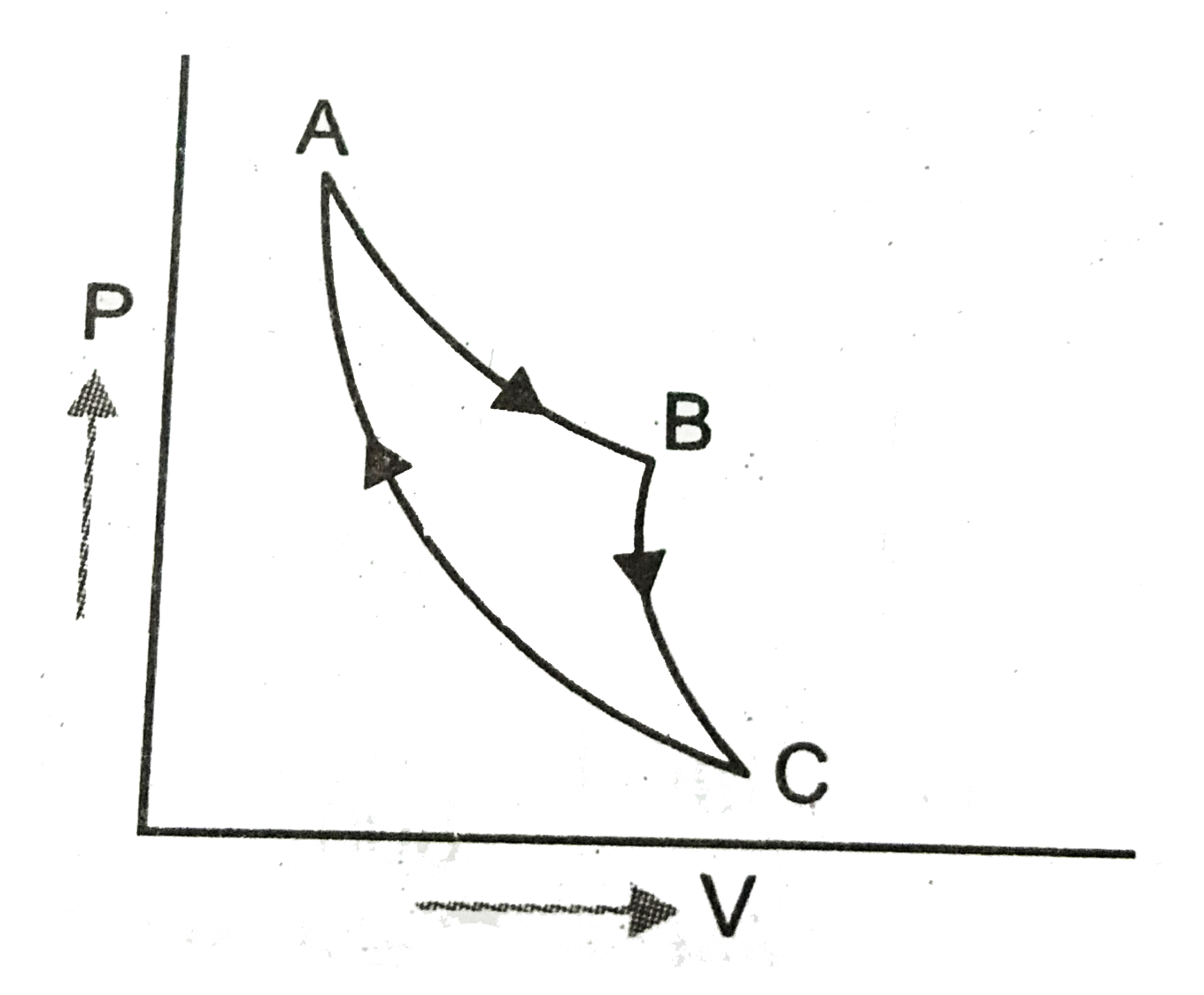 View Solution
View SolutionQuestion 131
An ideal gas having initial pressure P, volume V and temperature T is allowed to expands adiabatically until its volume becomes 5.66V while its temperature falls to T/2.
(i) How many degrees of freedom do the gas molecules have?
Obtain the work done by the gas during the expansion as a function of the initial pressure P and volume V.View SolutionQuestion 133
Two Carnot engines are operated in succession. The first engine receives heat from a source at T=800K and rejects to sink at T2K. The second engine receives heat rejected by the first engine and rejects to another sink at T3=300K. If work outputs of the two engines are equal, then find the value of T2.View SolutionQuestion 137
(Figure) shows that two P−V curves AB and BC for a gas: one is for isothermal process and other is for adiabatic process.
(i) Which curve denotes which change and why?
(ii) How much work will be done by the gas in change AB? Will the internal energy of gas increase or decrease? How much heat will the gas give or take?
(iii) Discuss all the above things in change BC.View SolutionQuestion 148
In a refrigerator, one removes heat from a lower temperature and deposites to the surrounding at a higher temperature. In this process, machanical work has to be done, which is provided by an elecrtic motor. If the motor is of 1KV power, and heat is transferred from −3∘Cto27∘C, find the heat taken out of the refrigerator per second assuming its efficiency is 50% of a perfect engine.View SolutionQuestion 150
The initial state of certain gas is (Pi,Vi,Ti). It undergoes expansion till its volume become Vf. Consider the following two cases :
(a) the expansion takes place at constant temperature.
(b) the expension takes place at constant pressure.
Plot the P−V diagram for each case. In which of the two cases, is the work done by the gas more?View SolutionQuestion 151
Consider a P−V diagram in which the path followed by one mole of perfect gas in a cyclinderical container is shown in (figure)
(a) Find the work done when the gas is taken from state 1 to state 2.
(b) What is the ratio of temperatures T1/T2,ifV2=2V1?
(c ) Given the internal energy for one mole of gas at temperature Tis(3/2)RT, find the heat supplied to the gas when it is taken from state 1 to 2, with V2=2V1.
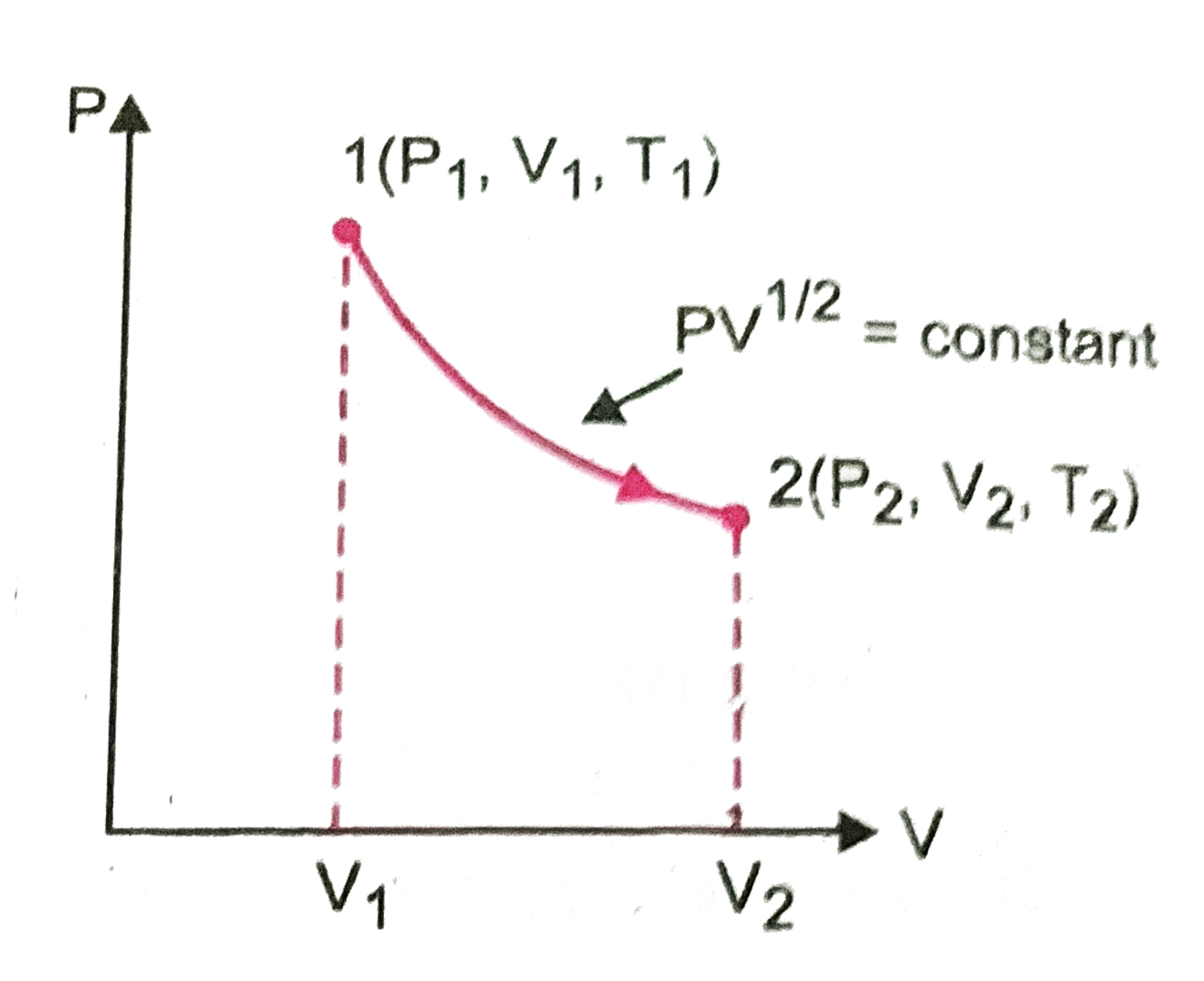 View Solution
View SolutionQuestion 152
A cycle followed by an engine (made of one mole of perfect gas in a cyclinder with a piston) is shown in (figure)
A to B: volume constant B to C: adiabatic
C to D: volume constant D to A: adiabatic
Vc=VD=2VA=2VB
(a) In which part of the cycle heat is supplied to the engine fron outside?
(b) In which part of the cycle heat is being given to the surrounding by the engine?
(c ) What is the work done by the engine in one cycle? Write your answer in term of PA,PB,VA.
(d) What is the efficiency of the engine? (γ=5/3for the gas), (Cv=32Rfor one mole)
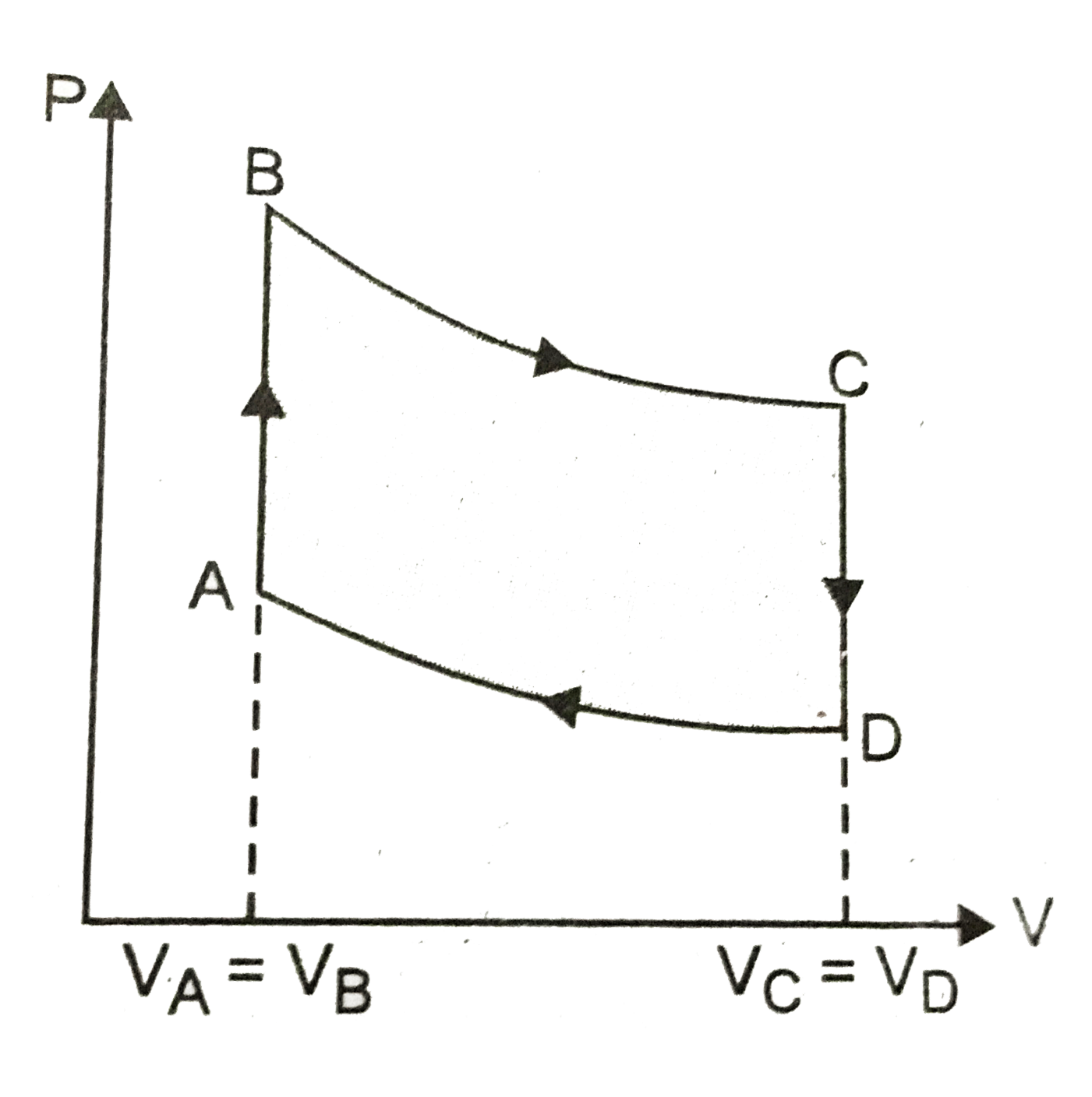 View Solution
View SolutionQuestion 153
A cycle followed by an engine (made of one mole of an ideal gas in a cyclinder with a piston) is shown in (figure). Find heat exchanged by the engine, with the surrounding for each section of the cycle. [CV=(3/2)R]
AB : constant volume BC : constant pressure
CD : adiabatic DA : constant pressure.
 View Solution
View SolutionQuestion 155
Consider one mole of a perfect gas in a cyclinder of unit cross section with a piston attached, (figure) A spring (spring constant K) is attached (unstretched length L) to the piston and the bottom of the cylinder. Initially, the spring is unstretched and the gas is in equilibrium. A certain amount of heat Q is supplied to the gas causing an increase of volume from V0toV.
(a) What is the initial pressure of the system?
(b) What is the final pressure of the system?
(c) Using the first law of thermodynamics, write down a relation between Q,Pa,V,V0 and K.
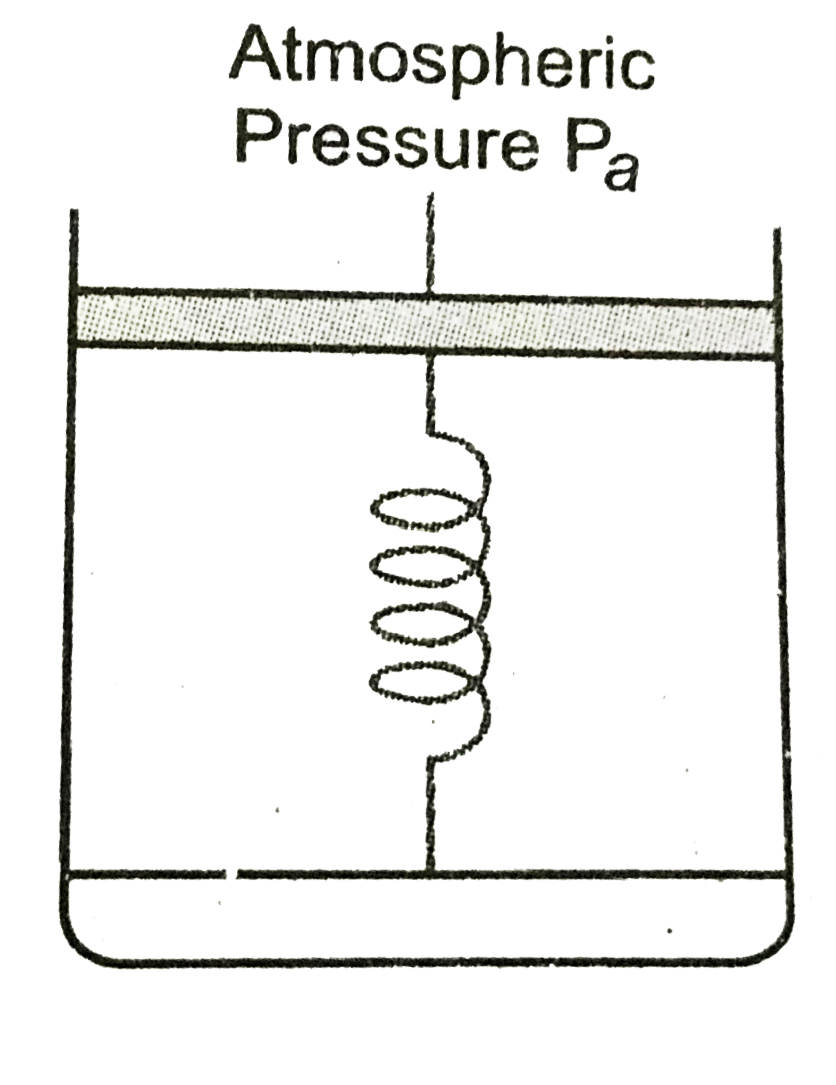 View Solution
View SolutionQuestion 157
A sample of 2kg of monoatomic helium (assumed ideal) is taken through the process ABC and another sample of 2kg of the same gas is taken through the process ACD as shown in (figure). Given molecular mass of He =4andR=8.3Jmole−1K−1
(i) What is the temperature of He in each of the states A, B, C and D?
(ii) How much is the heat involves in process , ABC and ADC?
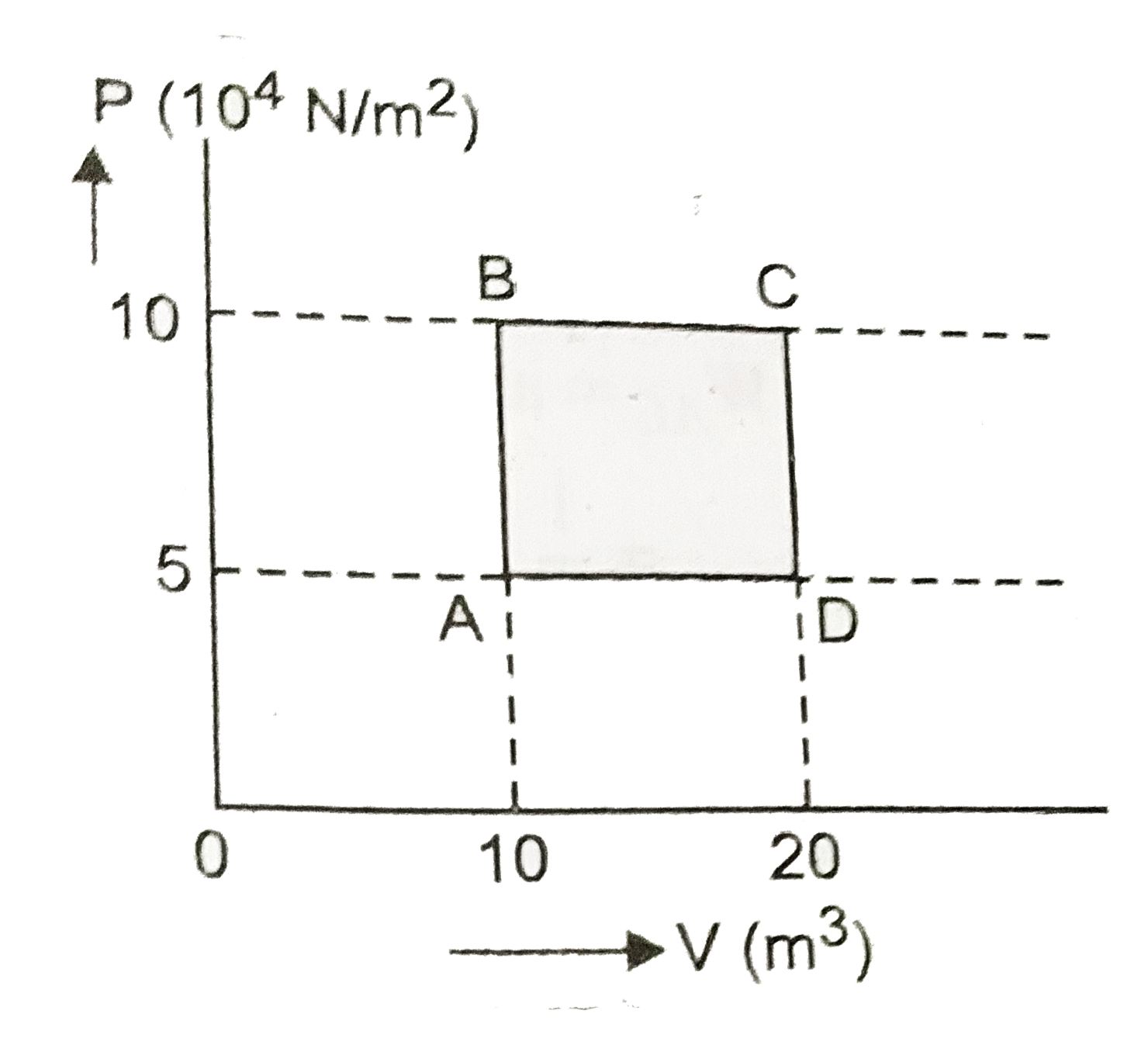 View Solution
View SolutionQuestion 158
Figure. Shows an ideal gas changing its state A to state C by two different path ABC and AC.
a. Find the path along which the work done is the least.
b. The internal energy of the gas at A is 10J and the amount of heat supplied to change its state to C through the path AC is 200J. Find the internal energy at C.
c. The internal energy of the gas at state B is 20J. Find the amount of heat supplied to the gas to go from state A to state B.
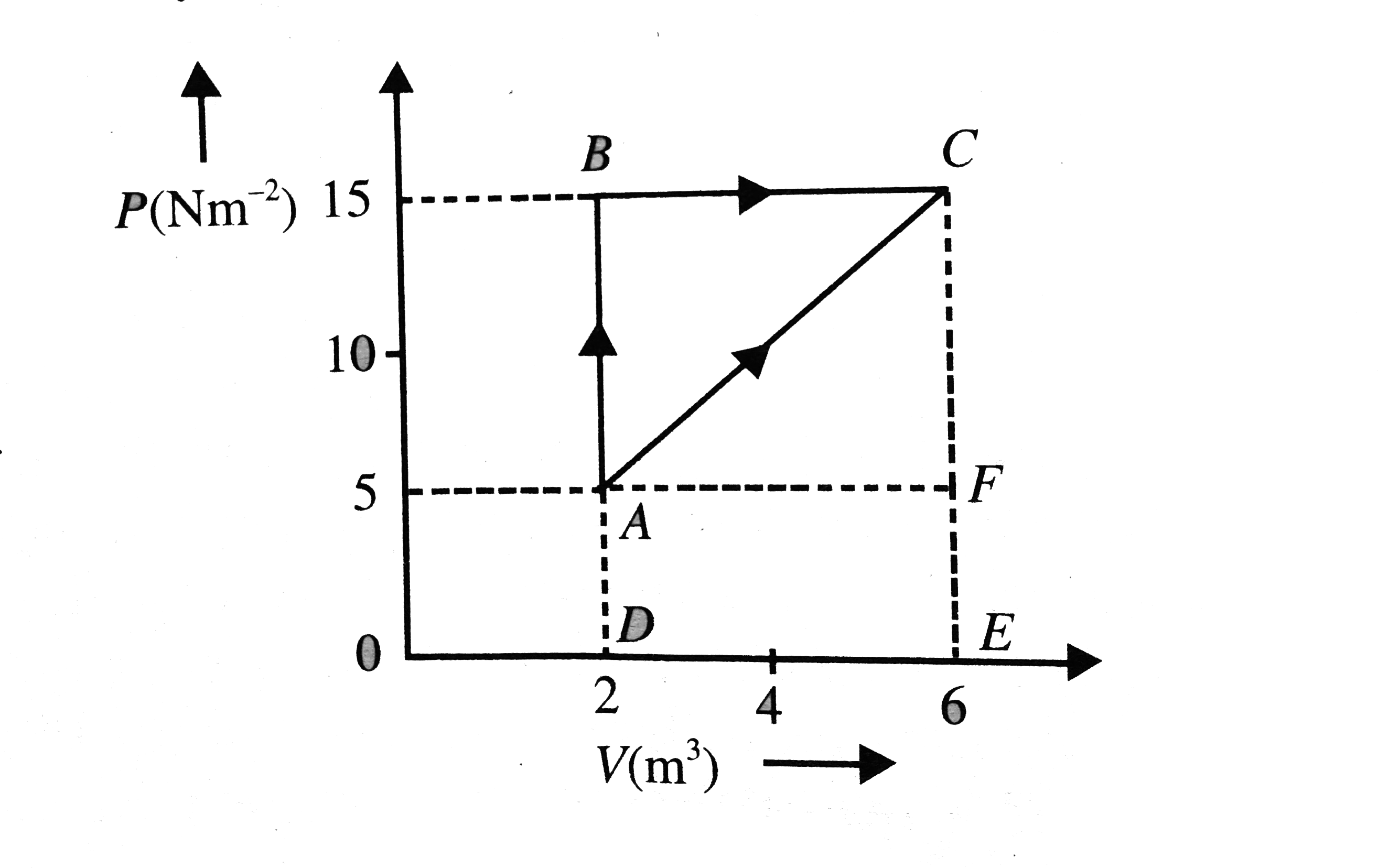 View Solution
View SolutionQuestion 162
A sample of an ideal gas is taken through the cyclic process abca . It absorbs 50J of heat during the part ab, no heat during bc and rejects 70J of heat during ca. 40J of work is done on the gas during the part bc.
(a) Find the internal energy of the gas at b and c if it is 1500J at a.
(b) Calculate the work done by the gas during the part ca.
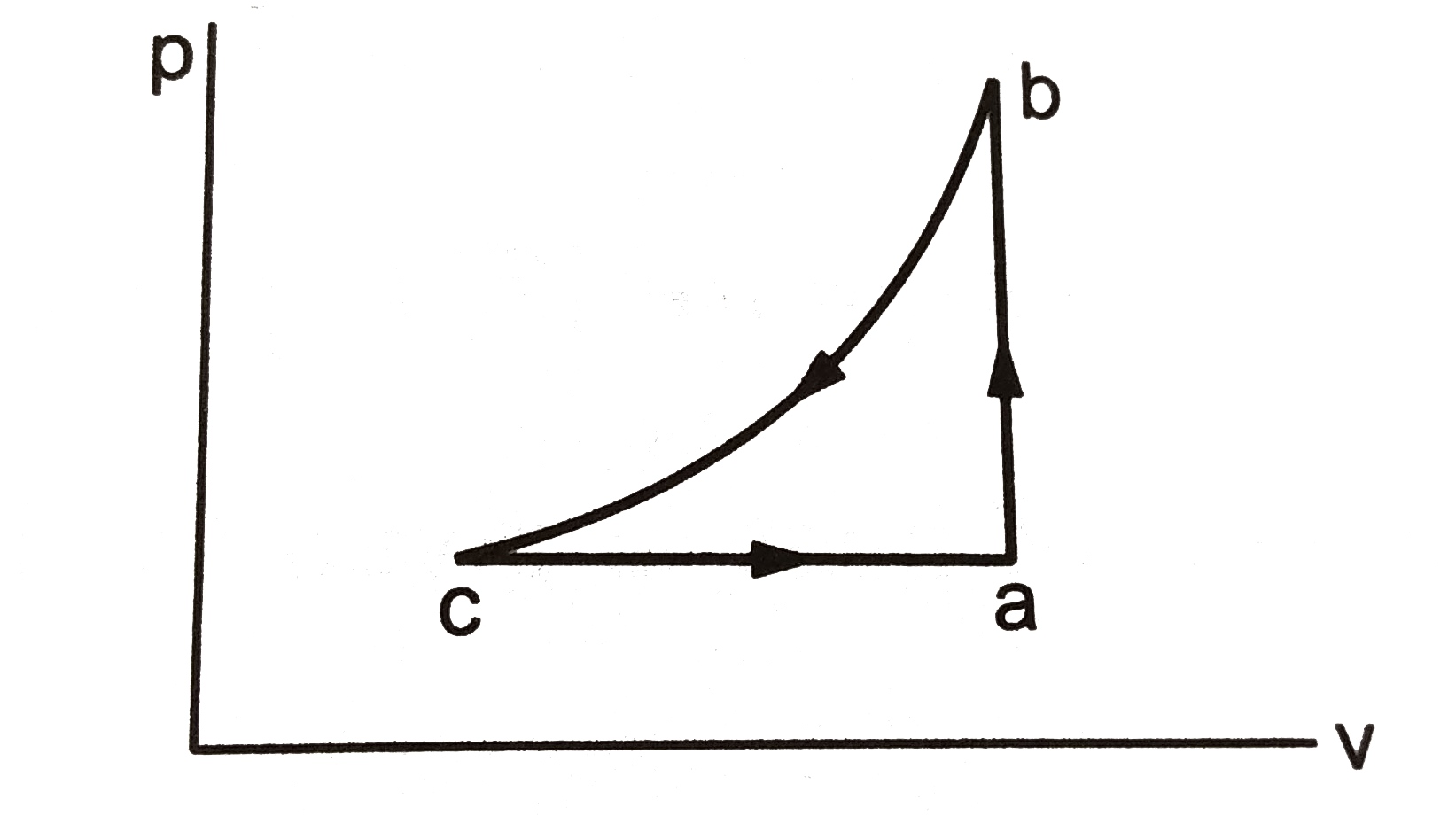 View Solution
View SolutionQuestion 163
The initial volume of an ideal gas is V1 and the initial pressure is P1=6 atmosphere. It expands isothermally to a volume V2 and pressure P2=3atm, and then adiabatically to a volume V3 and pressure P3=2atm. Draw a rough sketch of these changes. Calculate the value of V2/V1andV3/V2.
Take γ=1.4.View SolutionQuestion 165
A change in pressure and volume of a gas without any change in its temperature is called an isothermal change. In such a change there is free exchange of heat between the gas and its surroundings. Two essential conditions for a perfect isothermal change are :
(i) Walls of the container must be perfectly conducting
(ii)The process of compression or expansion must be slow.
Read the above passege and answer the following questions:
(i) A gas atmospheric pressure is compressed isthermally to one third of its volume. What is the final pressure?
(ii) What values of life do you learn from this study?View SolutionQuestion 166
A change in pressure and volume of a gas when no heat is allowed to enter into a escape from the gas is called an adiabatic change. Obviously, temperature of gas will change in adiabatic changes.
Two essential conditions for a perfect adiabatic chage are:
(a) the wall of the container must be perfectly non conducting.
(b) the process of compression or expansion must be sudden.
Read the above passage and answer the following questions:
(i) Pressure on a certain volume of air is doubled adiabatically. Will its volume become half, more than half or less than half? Justify.
(ii) What value of life do you learn from this study?View SolutionQuestion 167
First law of thermodynamics is the general law of conservation of energy as applied to heat energy. According to this law, whenever heat is added to a system, it transforms to an equal amount of some other forms of energy. If dQ= a small amount of heat supplied to the system, dW= small amount of work done by the system and dU= small change in internal energy of the system, then dQ=dU+dW.
Read the above passage and answer the following questions:
(i) The amount of heat obsorbed by a gas is 10cals and work done on the gas in 58J. Calculate increase in internal energy of the gas.
(ii) What values of life do you learn fron this law?View SolutionQuestion 168
A refrigerator is a device used for cooling things. Working substance would absorb a certain quantity of heat Q2 from the sink at lower temperature T2 and reject a larger amount of heat Q1 to the source (surrounding air) at higher temperature T1 (= room temperature) with the help of an external agency supplying energy W to the system.
Clearly, w=Q1−Q2
Cofficient of performance of refrigerator, βT2T1−T2=1−ηη
Read the above passage and answer the following questions:
(i) What is the cofficient of performance of a refrigerator working between −10∘C and 25∘C?
(ii) 'Refrigerator is an efficient room heater'. Do you agree with the statement? Justify.View SolutionQuestion 171
Explain why
(a) Two bodies at different temperature T1andT2 if brought in thermal contact do not necessarily settle to the mean temperature (T1+T2)/2 ?
(b) The coolant in a chemical or nuclear plant (i.e., the liquid used to prevent different parts of a plant from getting too hot)should have high specific heat. Comment.
(c) Air pressure in a car tyre increases during driving . Why?
(d) The climate of a harbour town is more temperature (i.e., without extremes of heat and cold) than that of a town in a desert at the same latitude. Why?View SolutionQuestion 172
A cyclinder with a movable piston contains 3mols of hydrogen at standard temperature and pressure. The walls of the cyclinder are made of a heat insulator, and the piston is insulated by having a pile of sand on it. By what factor does the pressure of the gas increases, if the gas is compressed to half its original volume? Given γ=1.4.View SolutionQuestion 173
In changing the state of a gas adiabatically from an equilibrium state A to another equilibrium state B, an amount of work equal to 22.3J is done on the system. If the gas is taken from State A to B via a process in which the net heat absorbed by the system is 9.35cal., How much is the net work done by the system in the later case? (Take 1cal.=4.9J)View SolutionQuestion 174
Two cyclinder A and B of equal capacity are connected to eachother via a stopcock. The cyclinder A contains an ideal gas at standard temperature and pressure, while the cyclindr B is completely evacuated. The entire system is thermally insulated. The stopcock is suddenly opened. Answer the following:
(a) What is the final pressure of the gas in A and B?
(b) What is the change in internal energy of the gas?
(c ) What is the change in temperature of a gas?
(d) Do the intermidiate states of the system (before settling to the final equilibrium state)lie on its P−V−T surface?View SolutionQuestion 177
A thermodynamic system is taken from an original state D to an intermediate state E by the linear process shown in (figure)

Its volume is then reduced to the original value from E to D via F by an isobaric process. Calculate the total work done by the gas from D to E to F to D.View Solution
All Exercises from PRADEEP PHYSICS (HINGLISH) Class 11 PHYSICS THERMODYNAMICS
- ASSERTION- REASON TYPE QUESTIONS
- INTERGER TYPE QUESTIONS
- MULTIPLE CHOICE QUESTIONS
- MULTIPLE CHOICE QUESTIONS (NCERT)
- MULTIPLE CHOICE QUESTIONS.
- PROBLEMS FOR PRACTICE
- ADVANCED PROBLEMS FOR COMPETITIONS
- CONCEPTUAL PROBLEMS
- CURIOSITY QUESTION
- HIGHER ORDER THINKING SKILLS
- LONG ANSWER QUESTIONS
- LONG ANSWER QUESTIONS(NCERT)
- NCERT QUESTIONS
- SAMPLE PROBLEMS
- SHORT ANSWER QUESTIONS
- SHORT ANSWER QUESTIONS(NCERT)
- SOLVED EXAMPLES
- VALUE BASED QUESTIONS
- VERY SHORT ANSWER QUESTIONS
- VERY SHORT ANSWER QUESTIONS(NCERT)

